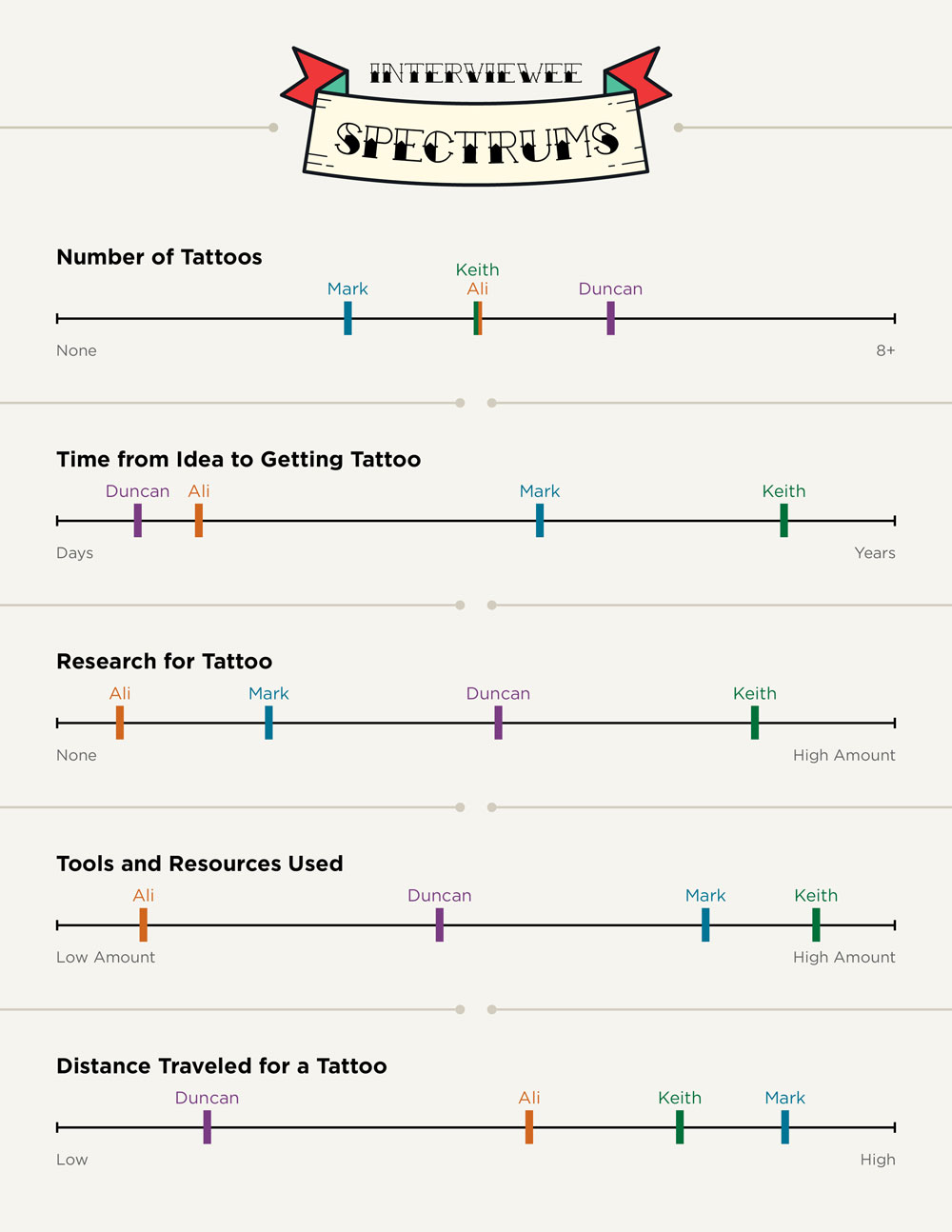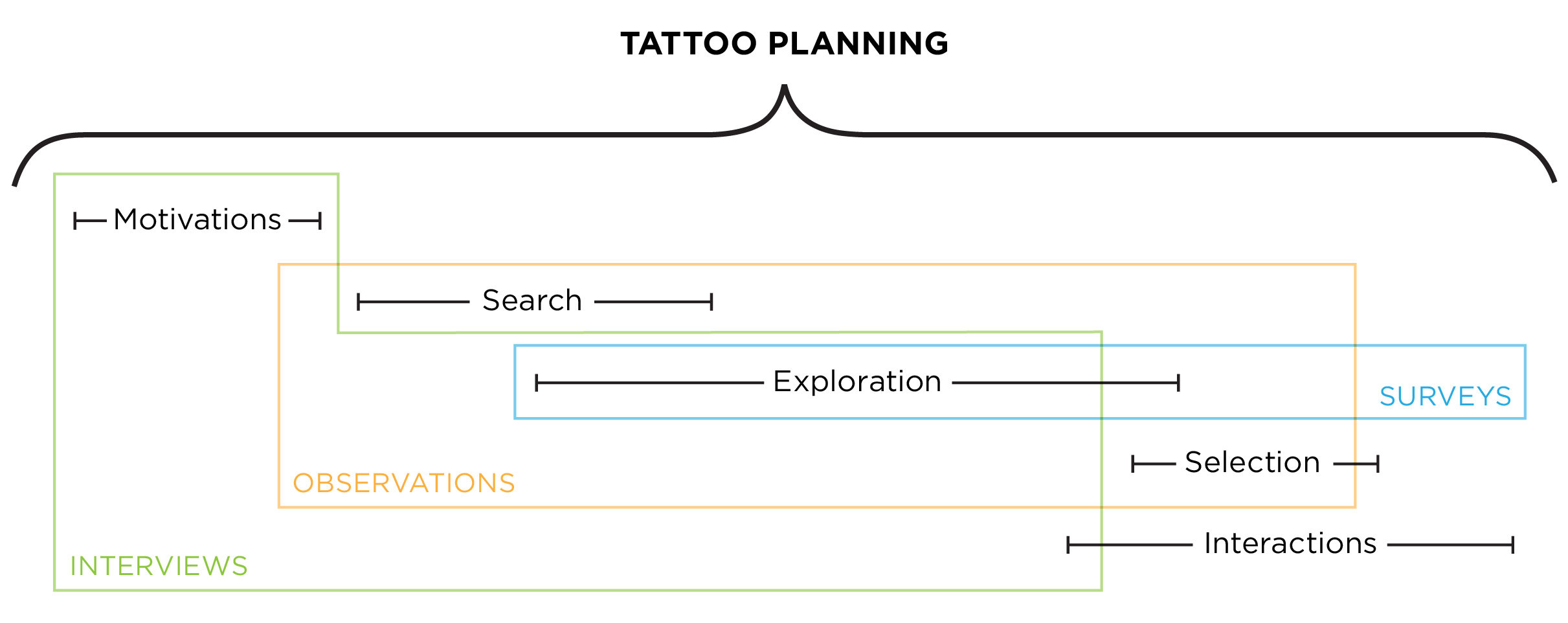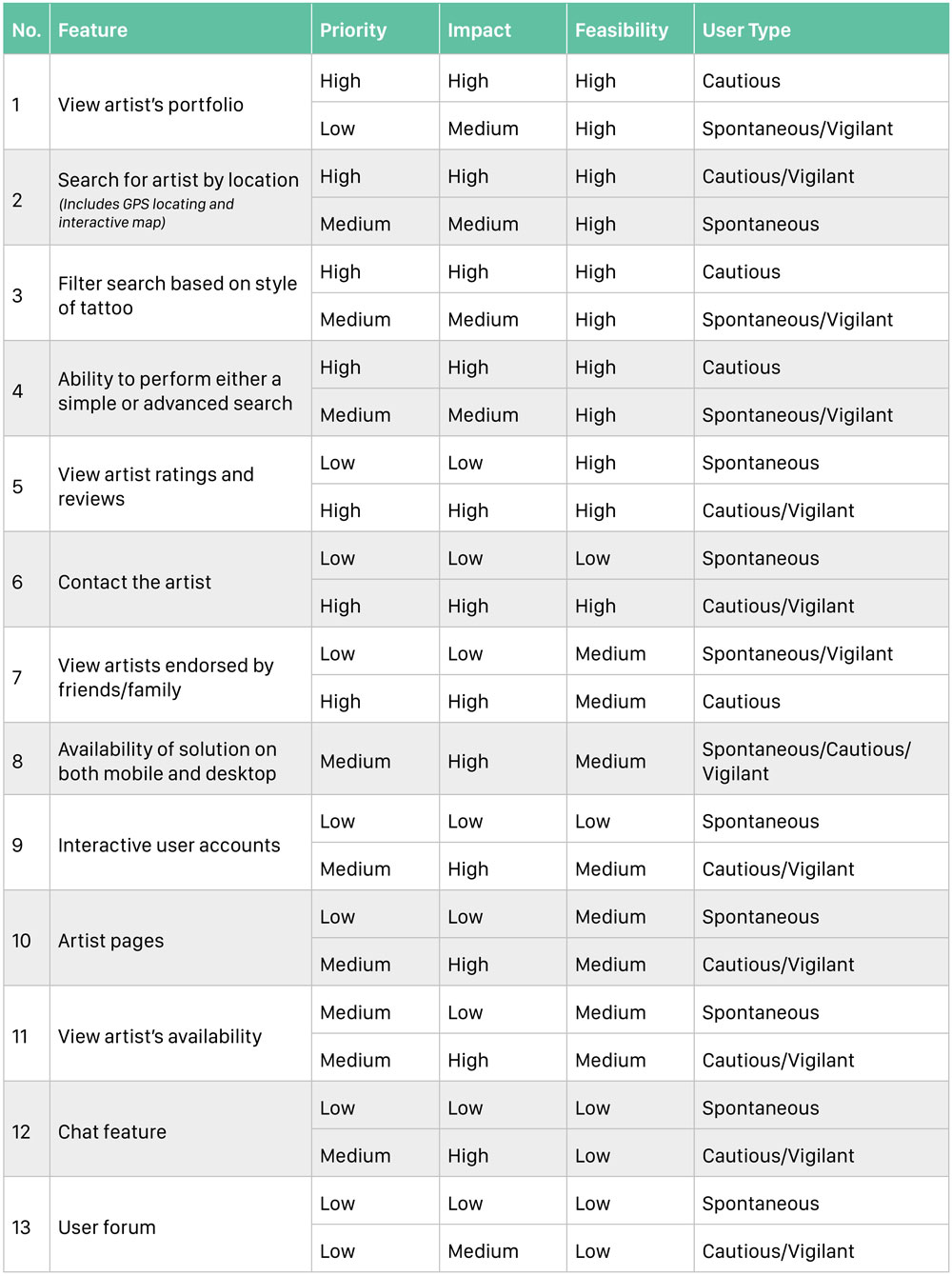This project outlines our team’s research-intensive investigation into how people plan for a tattoo. Information was gathered through a variety of methods, including observations, interviews, and surveys and then translated into proposed design features. The goal of this project was to conduct research that would answer the question, “How can the process of planning a tattoo be improved?” and would inform the development of a technology-based tool to help people with their tattoo planning. UX Researcher & Project Manager Sep – Nov 2017 • 4 Team MembersOverview
Role & Duration
Areas of Focus: Visual Design, User Research, Project Management
Although tattoos are increasing in popularity in the United States, and many people attempt to plan ahead before before going under the needle, there is currently no single resource available that helps people plan a tattoo from start to finish.
Tattoo research challenges include finding the right style of tattoo, finding an artist or tattoo shop, and booking an appointment with an artist. Since it is estimated that one-third of people regret at least one of their tattoos, we believe that creating an end-to-end tool or service could also reduce tattoo regret.
Our team first conducted a competitive analysis to determine current competitors on the market today
This resource displays different types of styles, a search database, and includes relevant articles. However, the application is lacking in three areas. First, it does not fully provide the start-to-finish process, that is, it fails to educate users who are new to tattooing. Second, it lacks contact information of artists and users cannot use the app to book an appointment. Lastly, the app does not afford filtering.
Many tattoo artists use Instagram to display their online portfolios and it does a good job of listing contact information and previous work. Users are able to find points of interest through hashtags and it can be used as a reference for a user to get ideas. However, it does not educate users about the tattoo process or provide reviews and ratings for the artist. It also does not allow for filtering.
After the competitive analysis, our team observed four participants that were planning to get a tattoo in the next 6 months, as they used a laptop or mobile device to locate a business/tattoo artist that would fit the style they are looking for. During the observations, we recorded notes and used the AEIOU framework to organize and analyze our data.
Those looking to get a tattoo begin with a search to start gathering information. Participants started the search based on location or style.
Results are evaluated and explored by the person based on their individual goals. All participants refined their search to a specific artist or shop.
Decisions and choices are made based on criteria that person has in mind. All participants looked through the artist’s portfolio to view their style.
A user flow diagram was then created to show the process we observed during the observations.
.
Next, our team interviewed four participants whom already had at least one tattoo and were planning to get a tattoo in the next 6 months to a year. All interviews were conducted in-person and lasted 30 minutes. We transcribed and compiled the recordings, then performed open coding exercises using attribute, descriptive, and in vivo sorting methods.
An individual’s motivations for getting a tattoo, such as an important life event, influenced their priorities when planning for their next tattoo.
An individual’s level of research into subject matter, style of tattoo, and tattoo artists greatly influenced their overall experiences with the process.
An individual’s interactions with the tattoo artist and the tattoo shop environment greatly influenced overall experience and satisfaction.
Participant’s motivations for getting a tattoo ranged from highly personal and sentimental to wanting a tattoo design because it’s aesthetically pleasing. Three out of four participants were motivated to get a tattoo to represent an important event in their lives, such as a marriage or finishing a postgraduate degree.
“The fourth tattoo I got post-graduation…so I got something symbolically representative of something that influences my daily life and impacts me.”
The participant’s level of research into the subject matter, style of tattoo, and tattoo artists influenced their overall experiences with the process. The amount of research was varied not only among each participant, but also among each tattoo they obtained.
“My most recent tattoo is my favorite because of…the amount of research I put into it. There’s more time invested into it. So I knew it wasn’t a spur of the moment thing, I knew this is what I wanted.”
Interactions between the participant and the tattoo artist and/or shop environment greatly influenced overall experience and satisfaction. All four participants mentioned the artist and tattoo shop when discussing both their good and bad experiences.
“Oh man, my second [tattoo] was good because the artist was just as excited about giving it to me as I was getting it. Tattoo parlors and artists can be kind of intimidating sometimes, so it was sweet to have an artist that was stoked to be putting it on me.”
.
Based on the findings from the interviews, we created an interviewee spectrum to understand the main differences between the participants. (Participant names have been changed.)

Lastly, our team conducted a survey directed at participants who have at least one tattoo. It was completed by 85 participants. We asked about previous tattoos, how they researched, and what technology they had used. We then analyzed survey results using descriptive and inferential statistics.
30% of participants got their first tattoo at age 18. 74% of participants had more than one tattoo. 58% have designed or helped design their own tattoos.
Participants rated skill of the artist (81%), sterilization (67%), and tattoo placement on body (66%) as the most important considerations.
48% of participants said they ‘always’ use Google to research and plan their tattoos. 68% rated the ability to view an artist’s portfolio as very important.
We created three personas based on the themes from our research findings. The first persona is Natalie Novice, a spontaneous/early canvas/low-informed researcher. The second is Eddie Experienced, a vigilant/experienced canvas/high-informed researcher. The third is Chris Creative, a cautious/creative researcher.
Based on our findings and the personas we built, we created an experience map showcasing a persona’s current journey planning a tattoo.
We found that our observation, interview, and survey participants planned tattoos using a variety of methods. However, all of our findings can be organized into five themes which occur at different moments during the tattoo planning process:

An individual’s motivations for getting a tattoo influenced their priorities when planning their tattoo.
People looking to get a tattoo begin with a search to start gathering information.
An individual’s level of exploration into subject matter, styles, and tattoo artists greatly influenced their experiences.
Decisions and choices are made based on criteria that person has in mind.
An individual’s interactions with the tattoo artist and the tattoo shop environment greatly influenced overall experience and satisfaction.
Based on insights from our research, we identified potential features and design implications for a technology-based solution that would assist people in planning their tattoo.

A new experience map was then created which shows a persona’s journey with a suggested solution based on the proposed features.
In this project, we aimed to understand the process of how people plan their tattoos; i.e. find information on and obtain a tattoo. Our research participants mentioned using current search tools that included social media networks, forum-based tools, and search engines. However, they also discussed frustrations and a lack of features with these existing tools, indicating a need for a technology-based tattoo-planning solution.
.
.
Email me or fill out the contact form linked below.
Contact Me